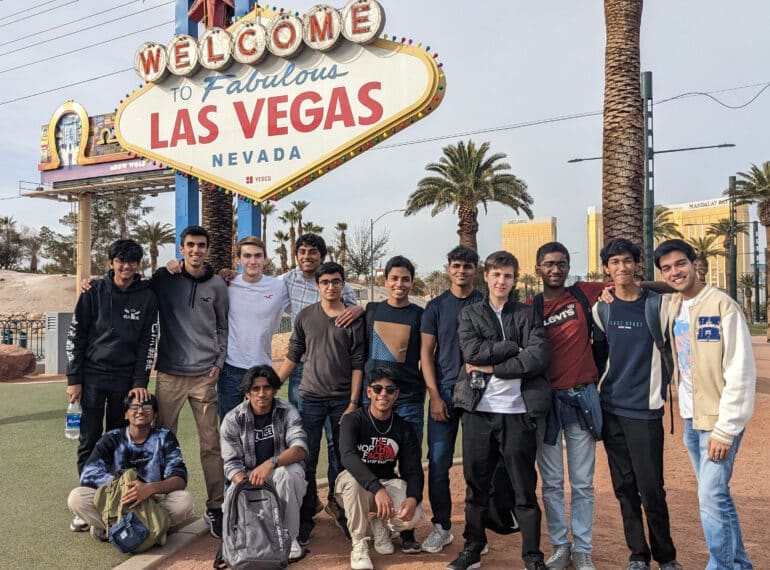
Two Year 12 squads flew the flag for Britain when they fought against more than 100 competing teams in the Battle for Vegas – an inaugural Vex Robotics Signature Event in the desert resort.
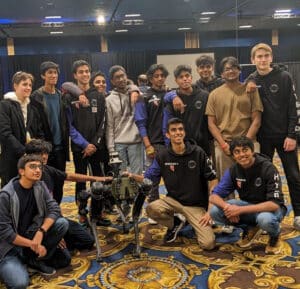 The QE boys, who made up the only teams from outside North America to attend, enjoyed both the competition and the chance to take in Las Vegas’s spectacular attractions.
The QE boys, who made up the only teams from outside North America to attend, enjoyed both the competition and the chance to take in Las Vegas’s spectacular attractions.
QE’s team Tempest finished their first day unbeaten, despite some daunting opposition, while team HYBRID struck up a strong relationship with an American partner team on day 2. In their time off, the sixth-formers revelled in the technical and architectural wonders on, around and even under the city’s glittering streets.
Head of Technology Michael Noonan, who accompanied the boys together with Technology teacher James Howard, explained that since the annual Vex Robotics World Championships in the US fall in the Summer Term, boys in years with public examinations are unable to attend. Instead, their teachers looked into suitable US-based Signature Events, which are events designed to provide competition at a level above that typically experienced at regional competitions. The QE teams, who are sponsored by Kingston Technology, opted for the one based at the Westgate Hotel and Resort in Las Vegas – the venue where, in July 1969, Elvis Presley performed two shows a night, seven days a week.
After their ten-hour flight from Heathrow, the AS students first replenished their strength at the Peppermill Restaurant, made famous as the backdrop of films and TV shows including Casino, The Cotton Club, and CSI: Vegas.
 They then made their way along Vegas’s celebrated Strip. “One highlight in particular was The Venetian – a resort and hotel, which boasts an indoor network of Venice-style canals, complete with singing gondola drivers!” said Mr Noonan. Further down the street, they took in the famous Welcome to Las Vegas sign and marvelled both at the water & light show at the fountain of the Bellagio and at the incredible complexity of the part-roller coaster, part-hotel New York New York attraction. “Racking up close to 30,000 steps over the course of the day was not enough, though, as the pupils made their way to the Area 15 entertainment complex, wondering at many of the audio-visual wonders on offer, and at the surreal Omega Mart [an exhibition billed as ‘an interactive, mind-bending immersive art experience’].”
They then made their way along Vegas’s celebrated Strip. “One highlight in particular was The Venetian – a resort and hotel, which boasts an indoor network of Venice-style canals, complete with singing gondola drivers!” said Mr Noonan. Further down the street, they took in the famous Welcome to Las Vegas sign and marvelled both at the water & light show at the fountain of the Bellagio and at the incredible complexity of the part-roller coaster, part-hotel New York New York attraction. “Racking up close to 30,000 steps over the course of the day was not enough, though, as the pupils made their way to the Area 15 entertainment complex, wondering at many of the audio-visual wonders on offer, and at the surreal Omega Mart [an exhibition billed as ‘an interactive, mind-bending immersive art experience’].”
After an early start the following morning – and a swift present-buying visit to the World’s Largest Gift Shop – the boys began preparations for their first formal day of competition. They started setting up their pit area, fine-tuning their build process and rehearsing their pro-programmed routines.
This day also brought a highly exclusive trip to the cutting-edge loop underground public transport system at the Las Vegas Convention Center created by Elon Musk’s The Boring Company. “The students were able to see state-of-the-art engineering developments, many of which are too secretive to even photograph!” said Mr Noonan.
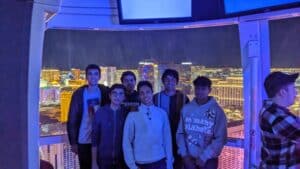 After this once-in-a-lifetime opportunity, the boys returned to their robotics, making final preparations for the following day of qualification, as well as taking part in some impromptu practice sessions. “As the only overseas team at the event, the other 100 or so US, Canada and Mexico-based teams were very eager to get to know the QE teams, with lots of potential alliance links formed,” said Mr Noonan. They topped off the day with a visit to the “incredible” High Roller observation wheel at The LINQ Hotel – a 550ft wheel offering breath-taking views over the Strip.
After this once-in-a-lifetime opportunity, the boys returned to their robotics, making final preparations for the following day of qualification, as well as taking part in some impromptu practice sessions. “As the only overseas team at the event, the other 100 or so US, Canada and Mexico-based teams were very eager to get to know the QE teams, with lots of potential alliance links formed,” said Mr Noonan. They topped off the day with a visit to the “incredible” High Roller observation wheel at The LINQ Hotel – a 550ft wheel offering breath-taking views over the Strip.
“On the first day of competition, team Tempest had, in keeping with their name, a storming day, despite their division featuring some of the world’s finest teams. They finished the day with a perfect record of five wins, leaving them ranked fifth in their division of 61 teams.”
Things proved a little tougher for team HYBRID, with last-minute fixes and alterations at times resulting in inconsistent robot performance. “However, they toughed it out and managed to finish the day with a record of three wins and two losses,” said Mr Noonan.
With little time to catch their breath, the teams were then off to Battlebots Arena – a permanent area purpose-built to showcase the highly popular Battlebots television show, yet featuring live robotic action. “They were thrilled to see famed robots from the television series, including Witch Doctor, Kraken, Mammoth, HyperShock and Whiplash. At the end of the event, they took photos with some of the engineers and team representatives, gaining an insight into the lives of professional robotic engineers.”
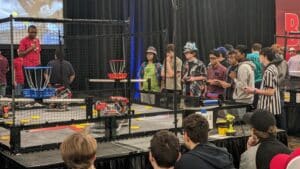 After their disappointments on day 1, team HYBRID began day 2 still determined to finish in the automatic alliance spots in their division. “They succeeded in doing so, finishing the qualification section ranked 21st, and allying with team 3303S Dublin Robotics from Dublin, California,” said Mr Noonan. “They built up a great relationship with them through collaboration and discussion over the two days and were always likely to pick this team. Sadly, there was further disappointment for them, as they were cruelly denied by disqualification on a technicality in their round-of-16 game.”
After their disappointments on day 1, team HYBRID began day 2 still determined to finish in the automatic alliance spots in their division. “They succeeded in doing so, finishing the qualification section ranked 21st, and allying with team 3303S Dublin Robotics from Dublin, California,” said Mr Noonan. “They built up a great relationship with them through collaboration and discussion over the two days and were always likely to pick this team. Sadly, there was further disappointment for them, as they were cruelly denied by disqualification on a technicality in their round-of-16 game.”
Having remained unbeaten in the early stages of competition, team Tempest did finally succumb to their only loss of the tournament, and finished the day ranked 13th. “They chose Team Fizzy, a former World Championship challenger from Omaha, Nebraska, and were unfortunate not to progress past the round of 16, following a loss caused by robot malfunction.”
The boys took in the overall finals, witnessing the “incredible consistency” of the eventual champion teams, Gears from Martinsville, Indiana, and Pink Sparklee Unicorns from Woodbridge, Virginia. “They managed to grab a photo with the champion teams – gaining some essential advice on how to continue to improve.”
As they got ready for their return flight, the QE teams were visibly exhausted, but were already planning that, after a short break, they would be preparing to go into battle once again, their sights set on a first QE VEX Robotics Championship win in three years, Mr Noonan said.

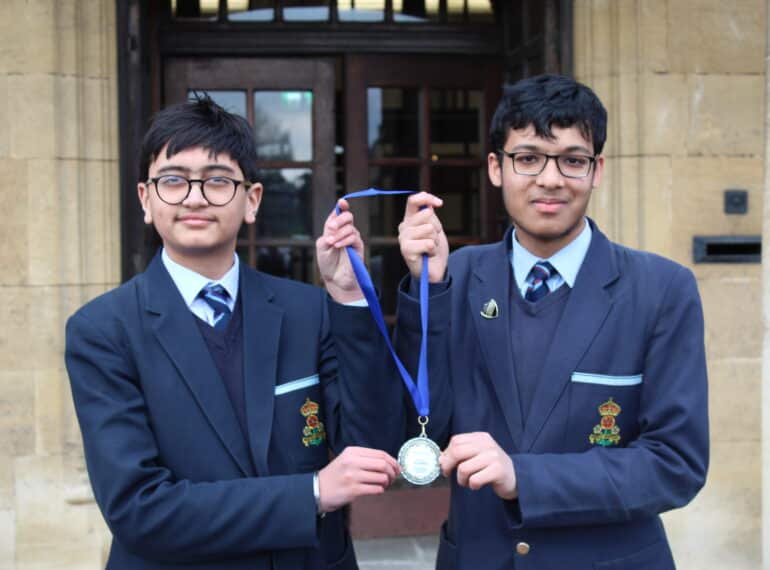
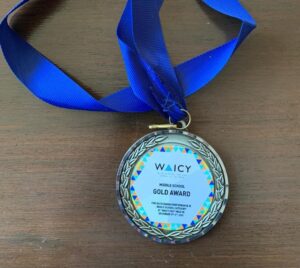 Paarth and Nittant won their medals and certificate for “outstanding performance”. Their project was designed to detect objects that are typically the subject of fly-tipping. They aimed to reduce the deleterious impact of fly-tipping on the environment and to help local authorities optimise their resources so that they can plan better and clean up more effectively.
Paarth and Nittant won their medals and certificate for “outstanding performance”. Their project was designed to detect objects that are typically the subject of fly-tipping. They aimed to reduce the deleterious impact of fly-tipping on the environment and to help local authorities optimise their resources so that they can plan better and clean up more effectively.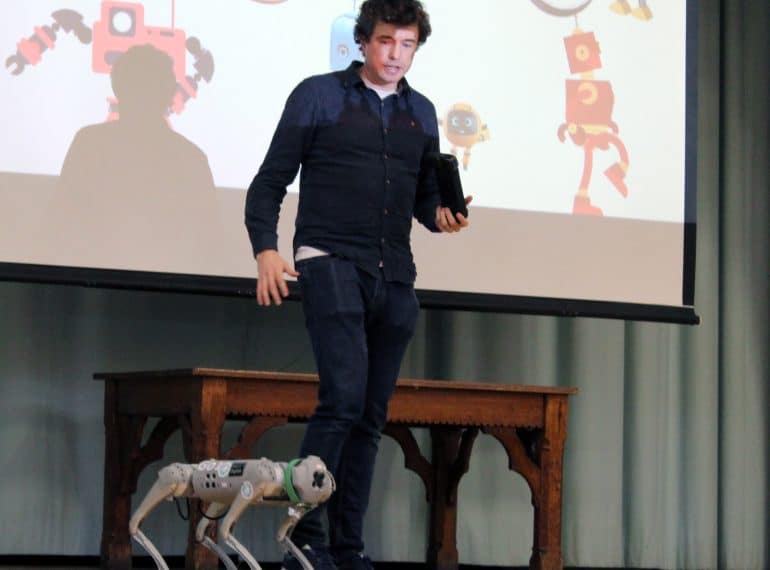
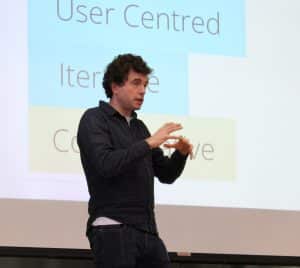 Mr Greig, who works for Deloitte Digital (part of the global Deloitte financial services and consultancy group) as its Chief Disruptor, made it through the snow to give a lunchtime lecture about his work, which involves working with new technologies to understand how they can benefit clients.
Mr Greig, who works for Deloitte Digital (part of the global Deloitte financial services and consultancy group) as its Chief Disruptor, made it through the snow to give a lunchtime lecture about his work, which involves working with new technologies to understand how they can benefit clients.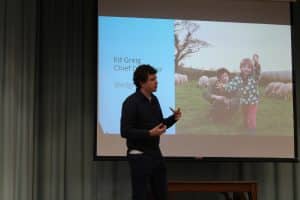 He gave the real-life example of a prosthetic arm for a six-year-old girl, where the issue was not merely the functionality of the limb, but making sure the girl would actually wear it by ensuring its design was fashionable and appealing, so that she would want to put it on.
He gave the real-life example of a prosthetic arm for a six-year-old girl, where the issue was not merely the functionality of the limb, but making sure the girl would actually wear it by ensuring its design was fashionable and appealing, so that she would want to put it on.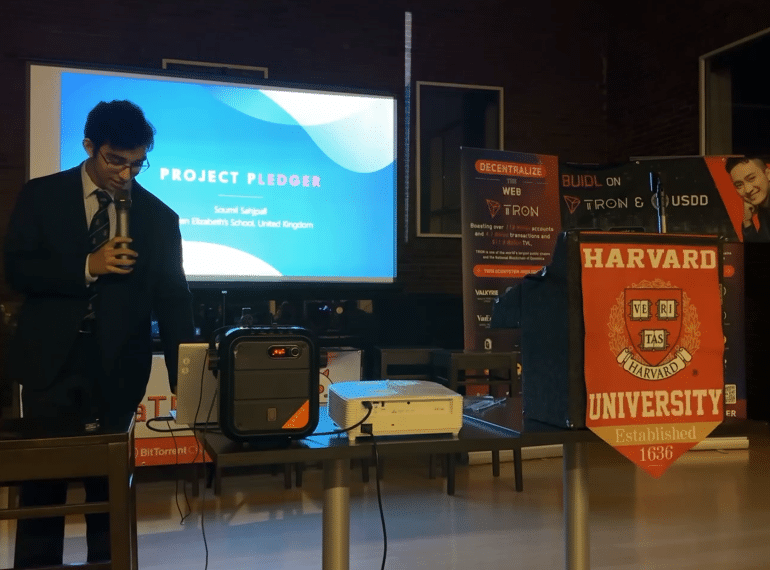
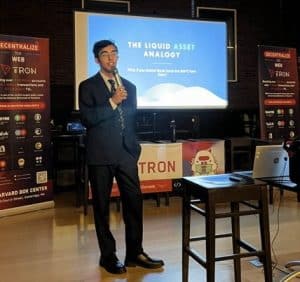 During his trip to the US, Soumil rubbed shoulders with Ivy League students as he developed blockchain software for cryptocurrency TRON in a coding marathon. His app earned him an ‘honourable mention’ from the judges, who placed him in joint-ninth place out of 55 teams.
During his trip to the US, Soumil rubbed shoulders with Ivy League students as he developed blockchain software for cryptocurrency TRON in a coding marathon. His app earned him an ‘honourable mention’ from the judges, who placed him in joint-ninth place out of 55 teams.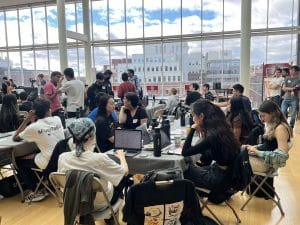 TRON, a leading cryptocurrency with a current market value of $5 billion, set a brief to develop a dAPP, or “decentralized app” – that is, software that runs on the blockchain, as opposed to on a server hosted by technology giants such as Amazon or Microsoft.
TRON, a leading cryptocurrency with a current market value of $5 billion, set a brief to develop a dAPP, or “decentralized app” – that is, software that runs on the blockchain, as opposed to on a server hosted by technology giants such as Amazon or Microsoft.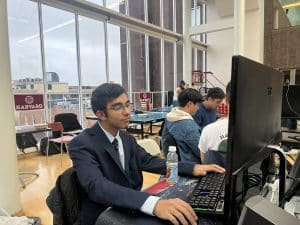 “I found out about this hackathon with relatively short notice, so I competed solo,” he said. “I was relatively confident in my abilities and knew I’d still be having lots of fun, so that was all right. The average team size was around four members – with a maximum of five – so I was at a disadvantage.”
“I found out about this hackathon with relatively short notice, so I competed solo,” he said. “I was relatively confident in my abilities and knew I’d still be having lots of fun, so that was all right. The average team size was around four members – with a maximum of five – so I was at a disadvantage.”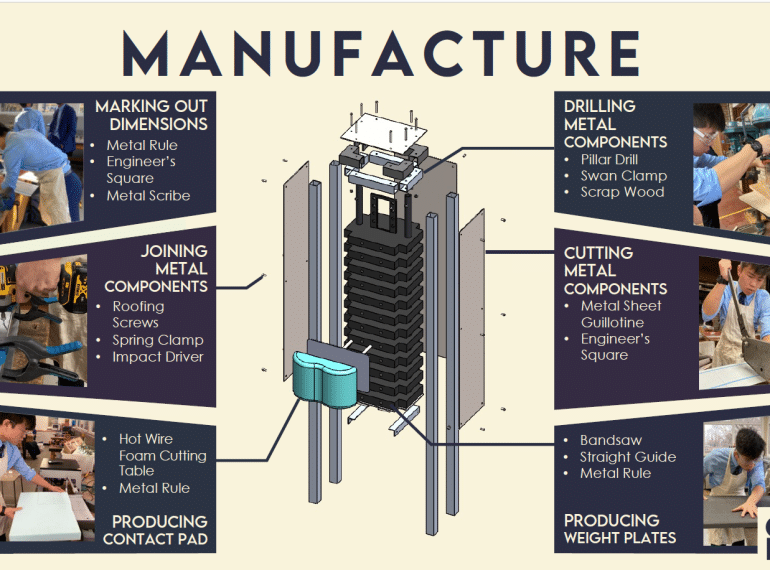
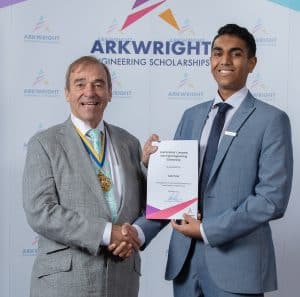 Darren Lee and Yash Patel laboured for months through a gruelling selection process for the scholarships, which will now provide them with financial and mentoring support during their A-level studies.
Darren Lee and Yash Patel laboured for months through a gruelling selection process for the scholarships, which will now provide them with financial and mentoring support during their A-level studies.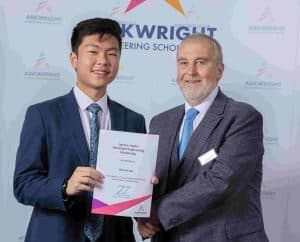 The process included an engineering aptitude test and an online interview, during which candidates had both to make a presentation and to respond to technical engineering questions.
The process included an engineering aptitude test and an online interview, during which candidates had both to make a presentation and to respond to technical engineering questions.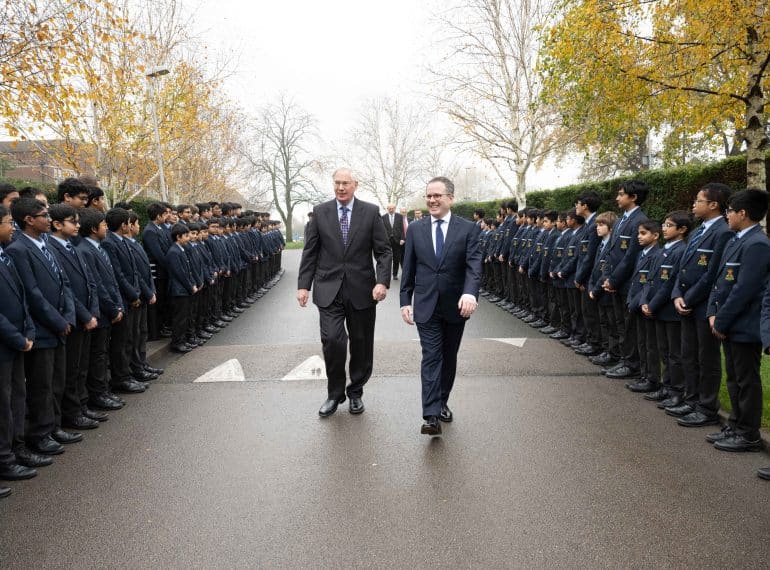
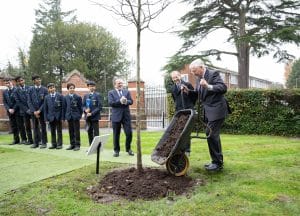 Members of the School’s Combined Cadet Force flanked the main entrance and the senior rugby team provided a sporting backdrop as the Duke arrived for his visit, during which he marked the anniversary by planting an oak tree and by presenting a specially embroidered banner to Headmaster Neil Enright.
Members of the School’s Combined Cadet Force flanked the main entrance and the senior rugby team provided a sporting backdrop as the Duke arrived for his visit, during which he marked the anniversary by planting an oak tree and by presenting a specially embroidered banner to Headmaster Neil Enright.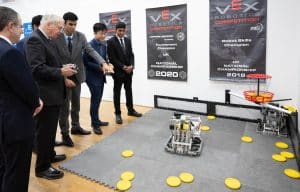 Following the visit, Mr Enright said: “It was a tremendous honour and my great pleasure to welcome HRH The Duke of Gloucester today. With the anniversary fast approaching, there was much to show him, including the School’s original 1573 Charter signed by Elizabeth I, our Ties through Time installation of 232 School photographs from the 1880s until comparatively modern times, and, to bring things right up to date, the robots and our new Music building, opened in May.
Following the visit, Mr Enright said: “It was a tremendous honour and my great pleasure to welcome HRH The Duke of Gloucester today. With the anniversary fast approaching, there was much to show him, including the School’s original 1573 Charter signed by Elizabeth I, our Ties through Time installation of 232 School photographs from the 1880s until comparatively modern times, and, to bring things right up to date, the robots and our new Music building, opened in May.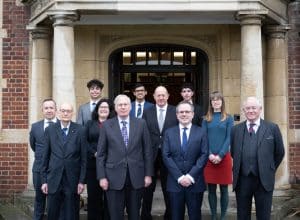 He was then introduced to:
He was then introduced to: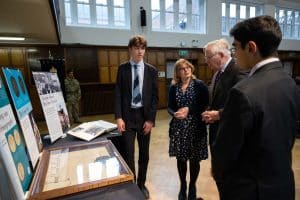 Gabriel Gulliford.
Gabriel Gulliford.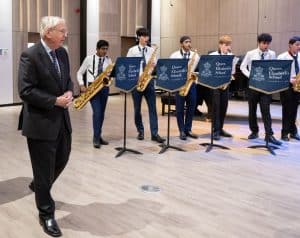 After visiting the Ties through Time photographic installation and enjoying the robotics in the School’s Conference Centre, the royal party headed to the new Music building to watch rehearsals for this Thursday’s Winter Concert under the watchful eye of Director of Music Ruth Partington.
After visiting the Ties through Time photographic installation and enjoying the robotics in the School’s Conference Centre, the royal party headed to the new Music building to watch rehearsals for this Thursday’s Winter Concert under the watchful eye of Director of Music Ruth Partington.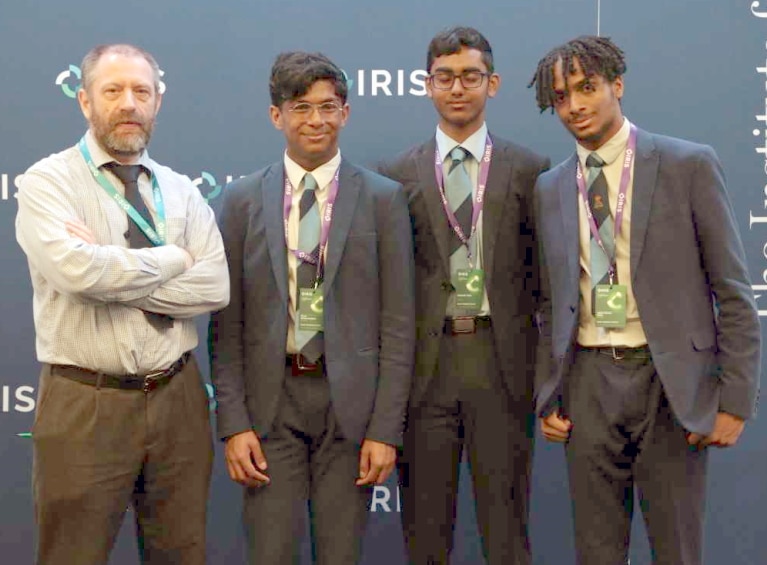
 Mr Brooke, who accompanied them to the conference, said: “Every step of the process was driven by the initiative of the boys, and it was fitting that one of the guests on the Scientist Panel that concluded the event, Dr Harshnira Patani, Senior Scientist Pharmacology at MSD (one of the world’s leading pharmaceutical companies), singled out the boys’ presentation as her highlight of the conference, making particular note of their use of machine learning.”
Mr Brooke, who accompanied them to the conference, said: “Every step of the process was driven by the initiative of the boys, and it was fitting that one of the guests on the Scientist Panel that concluded the event, Dr Harshnira Patani, Senior Scientist Pharmacology at MSD (one of the world’s leading pharmaceutical companies), singled out the boys’ presentation as her highlight of the conference, making particular note of their use of machine learning.”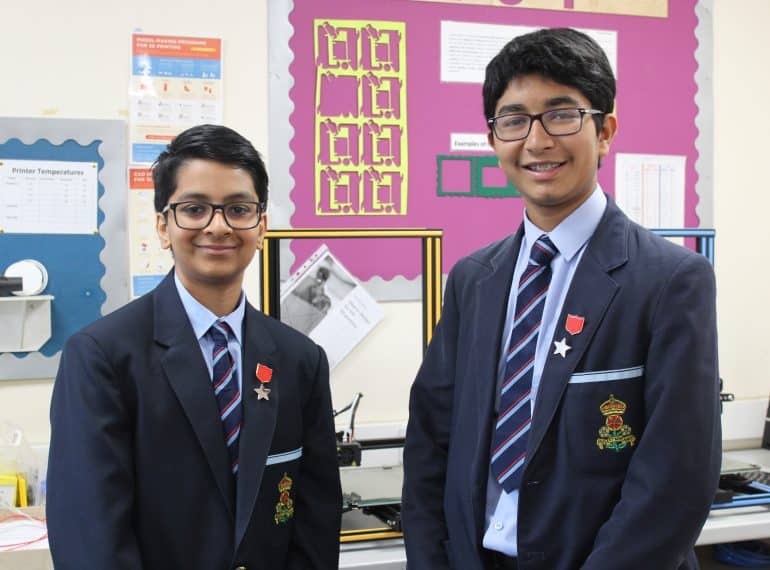
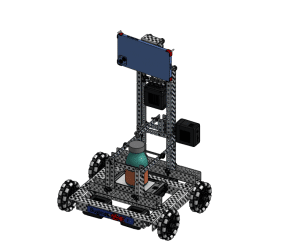 Their Buginator robot is designed to help farmers combat swarms of pests, thus protecting precious ecosystems while the farmers remain safely inside.
Their Buginator robot is designed to help farmers combat swarms of pests, thus protecting precious ecosystems while the farmers remain safely inside.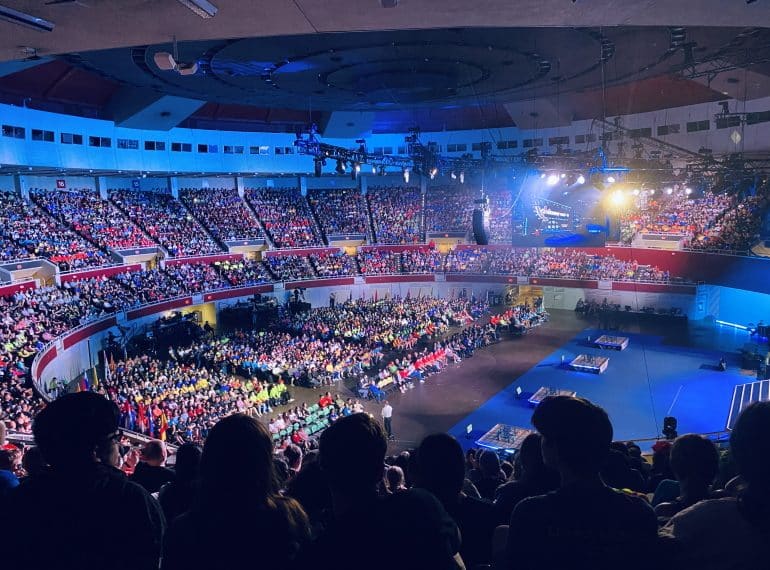
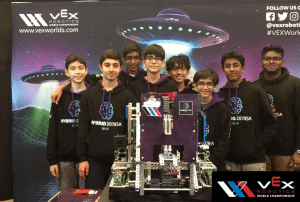 “The final stages of the match were met with rapturous applause from UK supporters…and Hybrid were suddenly the great hope of UK teams and mentors,” Mr Noonan said. “With this, confidence levels in the team grew, and they swatted the semi-final challenge of a once-again higher-ranked alliance with ease, with a score of 163-76.” Their “fairy-tale journey” then came to an end as they lost out to a very high-scoring alliance.
“The final stages of the match were met with rapturous applause from UK supporters…and Hybrid were suddenly the great hope of UK teams and mentors,” Mr Noonan said. “With this, confidence levels in the team grew, and they swatted the semi-final challenge of a once-again higher-ranked alliance with ease, with a score of 163-76.” Their “fairy-tale journey” then came to an end as they lost out to a very high-scoring alliance.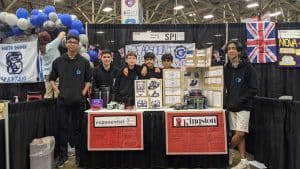 “All teams put in an incredible effort, but none managed to secure that coveted prize of a place in the world finals,” said Mr Noonan. Nevertheless, Gearsquad won an Inspire Award and a top-50 place for Skills, while Nova, Cyberforce, Rubber Bands and Eclipse all secured online challenge awards.
“All teams put in an incredible effort, but none managed to secure that coveted prize of a place in the world finals,” said Mr Noonan. Nevertheless, Gearsquad won an Inspire Award and a top-50 place for Skills, while Nova, Cyberforce, Rubber Bands and Eclipse all secured online challenge awards.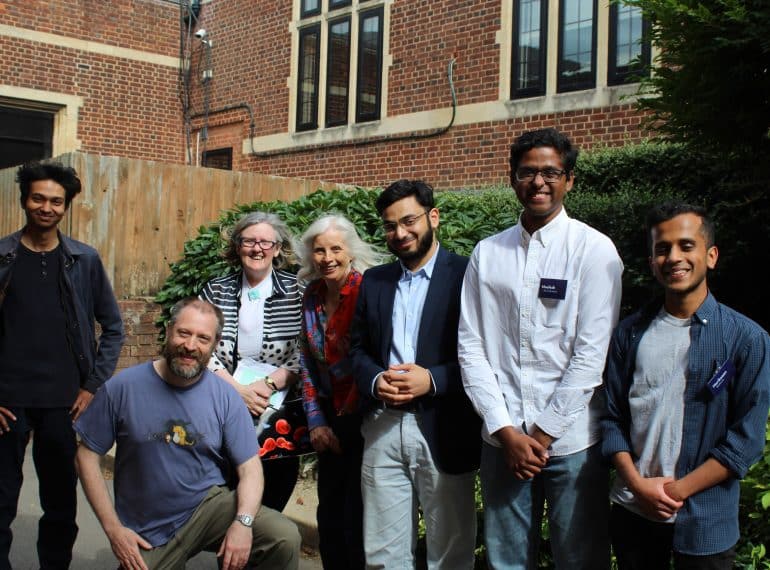
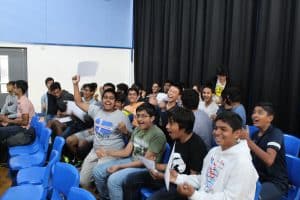 Lending their expertise and experience on the day were four 2017 leavers: Aadil Kara, Neelesh Ravichandran and Harikesan Baskaran and Suchira Peiris. Aadil, Neelesh and Harikesan all got through to the national stages of the UK Space Design Competition (Galactic Challenge’s ‘big brother’ for older pupils) when they were in Year 13, with Aadil going on to reach international level.
Lending their expertise and experience on the day were four 2017 leavers: Aadil Kara, Neelesh Ravichandran and Harikesan Baskaran and Suchira Peiris. Aadil, Neelesh and Harikesan all got through to the national stages of the UK Space Design Competition (Galactic Challenge’s ‘big brother’ for older pupils) when they were in Year 13, with Aadil going on to reach international level.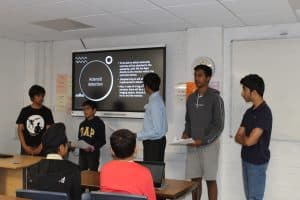 The challenge has two main objectives: to help foster pupils’ interest in Science, Technology, Engineering and Mathematics (STEM), and to help them develop so-called ‘soft skills’, such as team-working, communication, and the ability to solve complex problems.
The challenge has two main objectives: to help foster pupils’ interest in Science, Technology, Engineering and Mathematics (STEM), and to help them develop so-called ‘soft skills’, such as team-working, communication, and the ability to solve complex problems.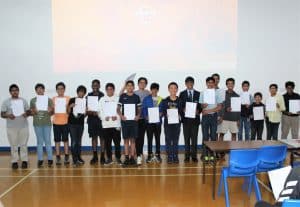 Suchira left QE to read Politics and International Studies at the University of Warwick, before securing a role as a consulting data analyst at the Information Lab. He said: “As a volunteer it was inspiring to see how engaged and active the students were in the competition, the out-of-the-box thinking, novel problem-solving and, in nearly every case, a board-worthy presentation!”
Suchira left QE to read Politics and International Studies at the University of Warwick, before securing a role as a consulting data analyst at the Information Lab. He said: “As a volunteer it was inspiring to see how engaged and active the students were in the competition, the out-of-the-box thinking, novel problem-solving and, in nearly every case, a board-worthy presentation!”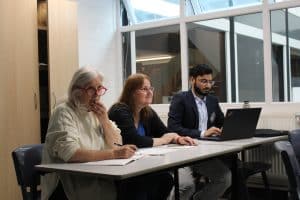 After trailing team Astrodyne Delta through the early stages of the competition, Solaris Flight Systems came through in the final stage to secure victory by the tightest of margins, winning contracts worth £320bn, against Astrodyne Delta’s £315bn. Infinity Airspace were not too far behind, on £300bn, with all three impressing the judges and securing contracts.
After trailing team Astrodyne Delta through the early stages of the competition, Solaris Flight Systems came through in the final stage to secure victory by the tightest of margins, winning contracts worth £320bn, against Astrodyne Delta’s £315bn. Infinity Airspace were not too far behind, on £300bn, with all three impressing the judges and securing contracts.